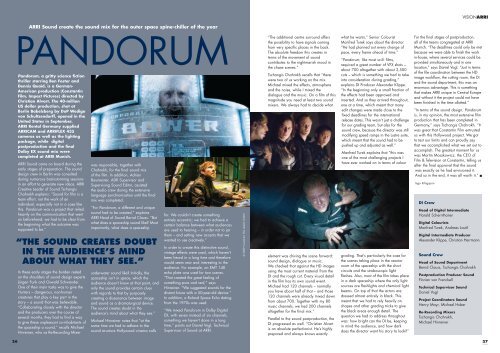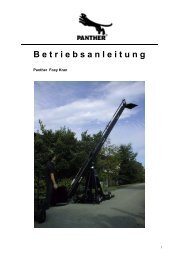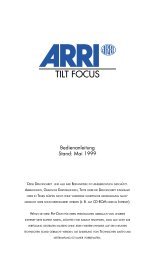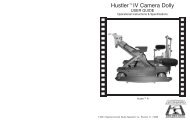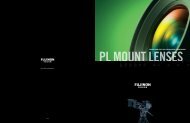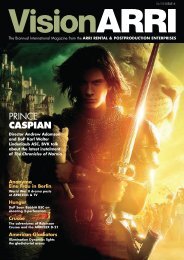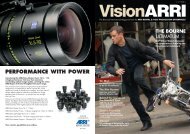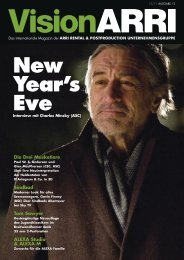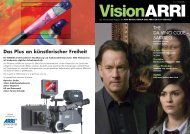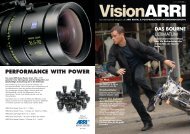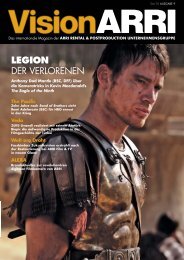Download English (PDF, 3.17MB) - ARRI Rental
Download English (PDF, 3.17MB) - ARRI Rental
Download English (PDF, 3.17MB) - ARRI Rental
You also want an ePaper? Increase the reach of your titles
YUMPU automatically turns print PDFs into web optimized ePapers that Google loves.
14<br />
GOING<br />
POSTAL<br />
Terry Pratchett’s Going Postal set for broadcast on Sky<br />
Following the hugely successful adaptations of Hogfather and The Colour of Magic, Sky has<br />
brought yet another novel from Terry Pratchett’s popular Discworld series to life. Produced by<br />
The Mob Film Company, Going Postal tells the story of con-artist Moist Von Lipwig, whose crimes<br />
finally catch up with him in the town of Ankh-Morpork. This latest feature-length television special<br />
will air in two 120-minute parts on Sky1 HD and Sky1 next Easter. Camera equipment was<br />
supplied by <strong>ARRI</strong> Media, while the lighting kit came from <strong>ARRI</strong> <strong>Rental</strong> Germany.<br />
Going Postal was shot on location in Budapest, Hungary,<br />
where the city’s architecture provided the backdrop for<br />
Pratchett’s famed fantasy town of Ankh-Morpork. Behind<br />
the camera once again was Gavin Finney BSC, making<br />
this the third Discworld adaption for both the<br />
cinematographer and The Mob, and also the third to be<br />
shot with the <strong>ARRI</strong>FLEX digital camera system. Although<br />
Finney had a history with the D-21, it was not a forgone<br />
conclusion that it would be used again when the project<br />
started. “This production had a new director, Jon Jones,<br />
and Jon had a free say in how he wanted his show to<br />
look,” explains Finney. “So we looked again at what was<br />
available to shoot on, but in the end it really became an<br />
aesthetic call. The D-21 does have a particular look that<br />
we liked, and I think for me the camera does have a<br />
slightly more organic, less electronic look than the others.<br />
They’re all good cameras, across the whole field, but<br />
some do look very, very clean and can be a bit too<br />
revealing. The D-21 is slightly more forgiving and digs<br />
less into the detail. It’s gentler on make-up, wigs and<br />
prosthetics, all of which are used a lot in these shows.”<br />
Having shot the previous productions in Linear mode,<br />
Finney selected Log C 4:4:4 RGB (extended range) for<br />
Going Postal, a decision largely driven by conversations<br />
with the visual effects department. “I think there’s a clear<br />
benefit in Log,” he says. ”It does seem to give more detail<br />
in the shadows and extended range gives you slightly<br />
more capture in the highlights, so the whole combination<br />
just gave us a bit extra.” The signal, which has to be<br />
processed through a look-up table (LUT) before it can be<br />
displayed, was previewed on set using sophisticated<br />
Cine-tal monitors, enabling Finney to monitor his image and<br />
make corrections or alterations by applying different LUTs.<br />
One of the key advantages for Finney was being able to<br />
capture Log DPX frames from the camera via the Cine-tal<br />
monitor, while filming. Using a grading programme called<br />
SpeedGrade OnSet by Iridas, he was able to establish looks<br />
by adding LUTs to the frames on his laptop. By using the<br />
SpeedGrade LUTs in combination with <strong>ARRI</strong>’s own LUTs<br />
and storing them on his computer, Finney created a visual<br />
reference for the entire production. The LUTs were also given<br />
o the editor to apply to the dailies. “The idea is that you get<br />
rushes that are closer to how you want them to look,” says the<br />
cinematographer, “and everyone else involved can see how<br />
you want them to look.<br />
“Those LUTs will be very useful when I come to do the online<br />
grade,” he continues, “as I’ve got an entire library of reference<br />
images and LUTs which I can share with the person doing the<br />
grade. That information is also very useful for the visual effects<br />
team, because they need to know how my material is going to<br />
look as well. They will have the Log material and I can give<br />
them a LUT that can be applied to the footage to show my<br />
intent in the grade. They can then be more confident when<br />
creating 3D animation or plates that their work is ultimately<br />
going to fit in with how things are going to look.”<br />
The Log signal from the D-21 was generally recorded onto<br />
Sony SRW-1 HDCAM SR recorders, but for Steadicam and<br />
handheld situations Finney chose to use <strong>ARRI</strong> Media’s newly<br />
acquired Panasonic P2 HD recorders, which can be mounted<br />
directly onto the D-21 with a simple bracket. “In the past we’ve<br />
run a cable to the SRW-1, but it can be a bit inhibiting if<br />
you’re on Steadicam, as you want to be free to move around,”<br />
he recalls. “We knew that the sort of shooting we were going<br />
“THE D-21 DOES HAVE A<br />
PARTICULAR LOOK THAT<br />
WE LIKED, AND I THINK<br />
FOR ME THE CAMERA<br />
DOES HAVE A SLIGHTLY<br />
MORE ORGANIC, LESS<br />
ELECTRONIC LOOK THAN<br />
THE OTHERS.”<br />
to be doing on this production was often going to involve 360s<br />
in large areas and the Steadicam operator didn’t want to have<br />
a cable on him because he felt it would pull the camera.<br />
“The P2 system looked like a great solution because with two<br />
32GB cards you can record up to an hour,” continues Finney.<br />
“It has its own lightweight power supply and as there are no<br />
cables, the camera becomes completely self-sufficient.” The<br />
cinematographer’s only concern was the fact that it records at<br />
25 fps in 4:2:2 and Going Postal was going to be shot in<br />
4:4:4, but it soon became clear that this would not be an issue<br />
for the handheld and Steadicam scenes. “The P2 was great for<br />
the operator,” asserts Finney. “It meant he was completely free<br />
and it worked flawlessly throughout the whole shoot.”<br />
DoP GAVIN FINNEY BSC using the D-21 Hand Crank<br />
Within the story, a series of flashbacks plague the main<br />
character, ultimately forcing him to realise the consequences of<br />
his past actions and change his ways for the better. After initial<br />
conversations about how the flashback sequences should look,<br />
it was decided that giving them the appearance of old film<br />
footage would make the audience instantly realise that the<br />
events had happened in the past. “We talked about how we<br />
were going to achieve the desired effect, whether it should be<br />
done in postproduction or whether it should be done incamera,”<br />
recalls the cinematographer, “and we’re always very<br />
keen to do as much as we can in-camera.”<br />
Finney researched footage from the archives of the British Film<br />
Institute, including some very old films produced by Mitchell &<br />
Kenyon – pioneers of early British cinema. It was initially<br />
thought that the flashbacks would be shot on a film camera,<br />
but after carrying out tests at <strong>ARRI</strong> Media, which included<br />
Super 8, Finney settled on the D-21 Hand Crank. “It worked<br />
remarkably well when we tested it,” he says. “You can literally<br />
set the camera up so when you turn the handle fast the camera<br />
goes quicker and when you turn the handle slowly the camera<br />
goes slower – just like an old film camera.” Once the decision<br />
was made to go with the Hand Crank Finney then looked at<br />
various lenses. “We tried it with modern lenses and then old<br />
lenses and finally chose the Lensbaby,” he continues. “It’s a<br />
neat, cheap little lens on a plastic bellows which you can use<br />
for quite unusual effects. It added a very realistic effect of<br />
poorly registered film along with an out of focus vignette.”<br />
Finally, to complete the look, Finney developed a black-andwhite<br />
LUT. “The whole combination – the Hand Crank with<br />
the Lensbaby and then going to black-and-white – looked<br />
amazingly like footage from the early 1900s,” he states,<br />
“which was exactly the effect we wanted to achieve.<br />
And it was all done on the D-21.” ■<br />
Michelle Smith<br />
VISION<strong>ARRI</strong><br />
15


